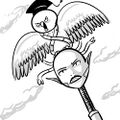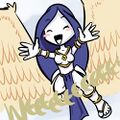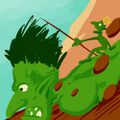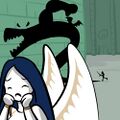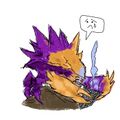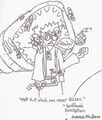Magic: The Gathering

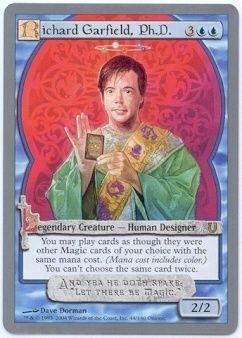
- – /tg/
Magic: The Gathering (or just "Magic") was a collectible card game created by Richard Garfield, and introduced to neckbeards everywhere in 1993. Much to the chagrin of "real" MtG players, it died in 1999, when everyone at Wizards of the Coast started doing massive amounts of acid and heroin and completely buttfucked the rules and card mix with 6th Edition. Since then, they have continued raping the game's corpse with such changes as the 8th Edition card layout, the M2010 rules, Bayformers, Justin Bieber, the Fifty Shades trilogy, and the 2016 US Presidential Election. Magic is notable for being the first CCG of all time, granddady of all Card Games, and its influence can be seen in almost every CCG since. It also has fucktons of fluff that is suprisingly fucking intricate and deep. Ink-Eyes comes from here, and is only depicted in one card.
Despite sharing the same build of title of World of Darkness settings, M:TG has nothing to do with White Wolf. It's also the best card game of all time. Let that sink in for a bit.
Story
Originally, the game really had no story, except that the two players represented wizards who were beating the shit out of each other for control of a plane, which is fantasy-speak for an entire universe within a multiverse called Dominia. Within a few months of the game's release, the "Antiquites" expansion set was released, depicting the story of a war between two brothers, Urza and Mishra, and introducing words like "Yawgmoth" and "Phyrexia". This kicked off an extremely long and convoluted plotline that was supposed to officially end with the "Apocalypse" expansion pack, but which WotC keeps dredging up and continuing because they haven't had a good, original idea since the Rath cycle. There have been a few side-plots along the way, but nobody really ever gave a shit about them because they sucked.
The Urza/Weatherlight/Rath/Phyrexia Saga
The beginning of this story is depicted in the prequel novel "The Thran". In this novel, a bunch of people (the eponymous Thran) are becoming sick and they have no idea why. Yawgmoth, a healer, eventually figures out that it's because they're wearing radioactive jewelry. He develops a crush on a girl, but she friendzones him, so he decides to surgically implant tons of radioactive jewelry into her boyfriend. The story ends with the Thran getting sick of his shit and banishing him to an empty plane, Phyrexia, where he sets up shop and starts using his knowledge of radioactive jewelry to start building an army of greasy steampunk zombies.
Fast-forward a few thousand years, to the events of the novel "The Brothers' War". Two young brothers, Urza and Mishra, go exploring in the Caves of Koilos and find a couple of magic rocks, the Mightstone and the Meekstone. Urza keeps the Mightstone and Mishra gets the Meekstone. Because the mightstone is bigger and better, Mishra spends most of his life suffering from Magic Stone Envy. Fast-forward maybe another 20 years. In a clever ripoff of "The Princess and the Pea", a king decides that he will only allow his daughter to marry a man who can lift a huge-ass piece of rock that no one can actually lift. Urza shows up and builds a humongous mecha that easily moves the rock. The king decides that this is good enough and lets them marry. However, the marriage is a disaster because it turns out that building humongous mecha and maintaining romantic relationships are two extremely different skill sets. Blah blah blah, war breaks out between the two brothers, entire continents are pillaged and despoiled as a result of the war, and Urza eventually wins by nuking half of the goddamn planet with a plot device called a Golgothian Sylex. The Sylex Blast turned Urza into a Planeswalker, guaranteeing that he'd continue to fuck up the entire multiverse with his drama for eons to come.
The ensuing nuclear winter was depicted in the expansion packs "The Dark", "Fallen Empires", "Ice Age", and "Alliances". Nobody really knows or cares about this part of the story, because they aren't about the Almighty Urza Christ, Peace Be Unto Him. Urza's adventures during this time are depicted in the novel "Planeswalker", where he decides to wage a one-man war against the Phyrexians, who he blames for turning Mishra into a robot. He starts by launching a LITERAL one-man attack against Phyrexia, where he gets ROFLPWN3D but manages to pick up a sexy female Phyrexian sidekick named Xantcha. Realizing that the successful destruction of Phyrexia would require him to be less of a dick and learn how to make allies, the two of them go to places like Shiv, Tolaria, and Serra's realm, which never ends well for the inhabitants of those places because the Phyrexians are constantly following him and fucking up everything everywhere he goes. He eventually decides that the key to victory will be to make a bunch of extremely powerful plot devices, which he calls the "Legacy", whose actual functions and purposes would be decided by whichever unfortunate authors got stuck with writing the end of this story. Some components of the Legacy included the flying ship Weatherlight and the silver golem Karn. He also bred an army of super-soldiers that he called the Metathran. These events are depicted in the novels "Time Streams" and "Bloodlines"
Eventually, the Weatherlight came to be crewed by a bunch of people who basically had no clue who Urza or the Phyrexians were, or what the Legacy was, or really anything that was mentioned in the above paragraph, because all of that shit was made up retroactively. In the anthology book "Rath and Storm", Sisay, the hot black chick who somehow became the Weatherlight's captain despite knowing nothing about it, has been kidnapped, and the rest of the crew, led by Gerrard Capashen, must hop from continent to continent, looking for clues to her whereabouts and picking up random hitch-hikers as they go, often for little or no reason. They track her down to the plane of Rath, where everything from the merfolk to the weather is Darker and Edgier. Some shit happens, they succeed in rescuing Sisay, and they also "rescue" someone who they THINK is Takara, daughter of Starke, a double-dealing backstabber that they allowed to come aboard because good is dumb. During their escape, however, they end up leaving two crew members behind: Crovax and Ertai.
The next three books and expansion packs, collectively called the "Masquerade Cycle", all take place during the same time frame but in different locations. "Mercadian Masques" follows the crew of the Weatherlight, who find themselves in an unknown plane called Mercadia, and who must figure out how to get back to their home plane, Dominaria (not to be confused with Dominia). This is also where "Takara" is, in fact, revealed to be Volrath, the Evincar of Rath, who manages to do absolutely nothing of importance in Mercadia and must find a way back to Rath. "Nemesis" follows the adventures of Crovax and Ertai after they are left behind. To make a long story short, they both turn to the dark side, and Crovax is appointed the new Evincar of Rath by Ertai's hot new Phyrexian girlfriend, Belbe, who dies immediately afterward. Volrath is also executed upon his return. "Prophecy", the third book and expansion pack in the cycle, was about overpriced cards that totally fucking sucked and a story that no one gave a shit about because it had nothing to do with anything else that was happening at the time, and can be safely ignored.
The Invasion cycle - Invasion, Planeshift, and Apocalypse - depicted the long-awaited Phyrexian invasion of Dominaria. Urza, the Weatherlight crew, the Elder Dragon Legends, over 9000 different kinds of Kavu, and everyone else came together to fight back against the endless army of greasy steampunk zombies. This resulted in the deaths of most major characters, the destruction of Phyrexia, and the transformation of Karn into a Planeswalker.
After that came the Odyssey and Onslaught cycles, which took place on Dominaria 200 years after the Phyrexian invasion. These stories sucked ass and depicted no events of major importance, except for the resurrection of the Slivers, a creature type from the Rath cycle that had proven insanely popular.
Then came a strange phase in MtG history, where WotC would alternate between unsuccessful attempts to dredge up the past with unsuccessful attempts to create new planes and stories that were worth giving a fuck about. Dominaria was revisited in "Time spiral" when WotC, realizing that something was amiss, but too high on acid and heroin to figure out what it was, decided that the only way they could get people to care about the story again was to bring back the old Weatherlight crew, which in turn required time travel, which in turn fucked everything up beyond human comprehension. The "Time Spiral" cycle also gave WotC an excuse to bring back Slivers AGAIN. Then came "Scars of Mirrodin", which took a formerly original plane and storyline and shoehorned the Dominaria/Phyrexia storyline into it.
Other storylines
Arabian Nights, Legends, Homelands, Mirrodin, Kamigawa, Ravnica, Lorwyn/Shadowmoor, Alara, Zendikar, Innistrad, Theros, Tarkir, Kaladesh, Amonkhet, and Ixalan all take place on their own planes and supposedly have their own stories, but no one has given enough of a shit to really find out. The real fans had all quit buying new cards by 2004 anyway.
Rules
There have been four versions of the rules (limited/Unlimited, Revised, 4th Edition, and 5th edition). After that, there was an endless series of unholy abominations that many people pretend are the rules, but which no real fans actually play by. For more information, go on /tg/ and ask about banding, bury, text on basic lands, interrupts, or mana burn. Do not ask about the tapped-artifact rule. That one was actually dumb and getting rid of it was one of the few things that 6th Edition got right.
Colors of Magic
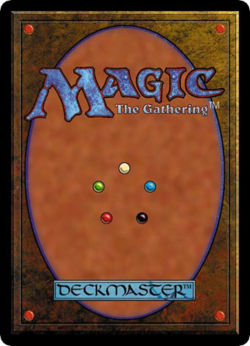
As well as having different types of cards, the game of Magic has five different colors to choose from when building a deck. It is important to have the appropriate type of land for the color of magic that you are playing with, since no basic land except a mountain can produce red mana, which is needed to play red spells. Certain effects are associated with certain colors, and only rarely if ever appear in the others - this is to ensure that the colors feel different to play, and that there is a point of having different colors in the first place. For a more thorough examination of the colors of Magic and their relationships with each other see Color Pie.
- White - This is the mostly goody-two-shoes or zealously genocidal, censoring and totalitarian (be it communist, or possibly other types of extreme) of the color pie, white often prevents damage to creatures and restore life to players. As excels with instant, sorceries, and enchantments that get rid off opposing creatures, with one of their main schticks being that the remove creatures from the game rather than sending them to the graveyard. They also have a tendency to have powerful creature enchantments to buff their creatures or prevent their opponents creatures from attacking or blocking. It is most notable for having the most non-damage boardwipes in the game. Among it's older cards are cards that create life gain win conditions. It has a general philosophy of having a large amount of small creatures instead a few big ones. White embodies law, order, community, healing, and light. White is the color most like and yet completely different from Black, both being absolute for entirely different reasons.The symbol for white is a sun. The white lands are plains. White's characters are either heroic and otherwise benevolent individuals such as Ajani Goldmane, Elspeth Tirel and Commodore Guff, or fanatical assholes like Konda and Elesh Norn.
- Blue - Blue is the color of logic, thought, observation, prescience, and arcane magic. It is the best color at things like countermagic, drawing cards, and using minor trickery to be a general pain in the butt. These things make blue the most effective color when used on its own, and the most hated by other players because blue played right will keep them from doing anything with their counter cards and will never run out of them, and blue players have a tendency to complain when WotC tries to do something to balance the counter spells. Thankfully, blue's creatures tend to the least effective at killing the opponent, in terms of strength and abilities, and blue also lacks the ability to deal with things if it can't counter them. Of course, Blue makes up for that by having the most cards that allow you take control of an opponent's creature (All the colors have some, having the most in the following order: Blue, Red, Black, Green, and White with exactly 1). Blue is generally the opposite of Red, similar to reason and emotion, and likewise have elements of each other. Thus, the two will generally make the most scientific and steampunk decks when put together. Blue concerns itself with such things as logic, water, science, knowledge, divination, time, and air. The blue symbol is a drop of water. The blue land is an island. Blue's most foremost Planeswalkers include Jace Beleren, Tezzeret and Bo Levar.
- Black - Black is the more diabolical of the colors, in brooding desire for any of the following, not necessarily exclusive of each other: independence in an oppressive world, inordinate wealth, immortality, godhood, control of others, vengeance, veneration of evil, world conquest, by any means. It is the color of self-interest, individuality, moral relativism, and devil's bargains. It often has the ability to emulate other colors to a lesser degree... for a cost. The more powerful black creatures sometimes turn on their player. It also contains lots of abilities that require sacrificing creatures, forcing the opponent to sacrifice creatures, killing opposing creatures, and the best discard abilities. As an intentional weakness, black lacks any significant artifact or enchantment kill. Black contains such things as sickness, destruction, necromancy, death, murder, blood rituals, assassination, crime, torture, darkness, and corruption. A skull is the symbol for black. The black land is a swamp. Black is the color most like and yet completely different from White, both being absolute for entirely different reasons. Black has spawned many infamous Planeswalkers such as Leshrac, the Walker of the Night; Tevesh Szat, the Doom of Fools; Liliana Vess and Nicol Bolas (well he's actually multi-colored, but the center of his shard is black), the Eternal Serpent and Lord of the Blind Eternities. In addition, it has a few heroic characters such as Sorin Markov and Toshiro Umezawa, proving that it is not inherently evil.
- Red - Red is the color of passion, freedom, and rage. Red contains some of the more self-destructive cards of the colors, but the power of the effects usually make up for it. Many of red's spells focus on directly damaging the opponent, players call them "burn spells", and in fact it's completely viable to run a red deck with no creatures and just burn spells. Red is generally the opposite of Blue, similar to emotion and reason, and likewise have elements of each other. Thus, the two are generally make the most scientific decks and steampunk decks when put together. The domain of red is such things as speed, destruction, fire, angry mobs (green and white have a fair and smaller share of these), lightning, dragons, and recklessness. Red's symbol is a ball of fire. The red land is a mountain. Some of Red's most famous Planeswalkers are Jaya Ballard, Lord Windgrace of Urborg and Chandra Nalaar.
- Green - Green associates itself with nature and the cycle of life, growth, exploration of the wilds, and brute strength. It usually has the most powerful and straight-forward creatures, which also have the best ratio of power and toughness for the mana cost. Green contains cards that can increase the strength of your creatures, cards that give you more mana more quickly and give you access to the other colors of mana, and cards that let you create and profit from large numbers of small creatures or small numbers of very large creatures. Green is the least common color run on its own because it needs to use small easy to kill creatures to get shit done, but is commonly put in other decks as a side color. The green symbol is a tree. The green land is a forest. Green's famous Planeswalkers include Garruk Wildspeaker, Nissa Revane, Kristina of the Woods and Freyalise.
- Colorless - Colourless (Grey) mana is composed of two things: non magic-artificial creations including some robots and laser cannons, and Cthuhloids. Mana of any color can be used for colorless mana costs. This is useful to ease the stress of colored mana requirements in multicoloured decks, and making cards that can fit in decks of any color - Artifacts are usually colorless. Artificial creatures cannot become Planeswalkers (but this does not stop them from trying to become them, as Memnarch has demonstrated), but they can inherit or obtain the power somehow: Karn the silver golem is as far as known the only one to have done so. The only other colorless planeswalker is Ugin, who's basically Magic Buddha because he's so enlightened that he's transcended the five colors.
- As of Battle for Zendikar, colorless has its own land type, which is Waste, and its own symbol, which is a grey four-pointed star. This specifically-colorless mana is used primarily for the Eldrazi, which are the freaky babies of Cthulu and Galactus. The Eldrazi are so ancient that they precede the planes and color itself. Yeah, that's right, they're older than even the game and fluff itself can even comprehend.
It is possible to build decks that are a mix of more than one color - in fact there are many spells that require anything from two to five different colors of mana to play. It is however not advisable to have more than 3 colours in a single deck unless you know what you are doing, since it'll begin to become a problem to get access to all the different colours of mana you need during play. This means you'll be left with a hand full of cards you can't play, and a table full of lands you have no use for - not a good position to be in. The full extreme of this is to have all five colors in your deck, which is something referred to as WUBRG (after the letters for each color). Unless (and even when) you know exactly what you're doing and built a deck around the concept, WUBRG is very difficult to play.
Players
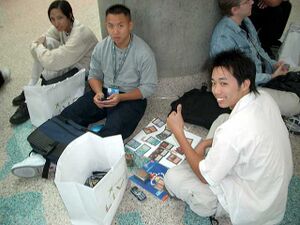
The developers of Magic have put out their 3 archetypes of players:
- Timmy - The player who just wants to experience something cool, something you can tell stories about. Often it's through casting gigantic creatures and game-changing spells, not caring that they're frequently too expensive to be much good at winning the game. Social gamers or even griefers can also be considered a type of Timmy; after all, the story you're telling doesn't always have to be about the game itself.
- Johnny - A combo player, these are the guys who'll spend days looking through cards to find a bizarre combo of cards that makes them win the game if they can pull it off. They often end up building decks that don't participate in the game itself, and are more oriented on getting their combo into play, turning the game into a sort of solitaire.
- Spike - The competitive player of the bunch. They'll build decks to win and only play to win, their fun is in winning, and sometimes turn the game into an obnoxious competition, even outside of tournaments. Needless to say, they're highly disliked at social games when they even bother showing up outside of a competitive setting, even when they mean no harm. On the other hand, it also means that their decks are made to work effectively and will win more often than not. That isn't to say Spike will put up with everything just to win. For example, some Spikes might hate it when only a few strategies are viable, or conversely when too many are viable and it's impossible to prepare against them all.
The three archetypes mix and match, meaning that it is possible to be a Johnny-Timmy player, aiming to make some kind of combo that'll give you a million life and an army of 100/100 creatures or some other kind of stupid nonsense.
Recently, it has come to light that there are 2 more pseudo-archetypes, though these aren't really archetypes proper. The types here are on a separate axis than the aforementioned three. They are as follows:
- Vorthos - Vorthoses care about flavour and the story part of the game. They'll build a deck that re-enacts the forces Urza rallied to fight the Phyrexians. Fluff is of key importance in the mind of a Vorthos. Stories, art, flavour text, and block novels are all things that a Vorthos focuses on. As a result, it can be considered to be a close relative of the Timmy, with the emphasis on "cool things" being replaced by a stronger focus on fluff-accuracy. As a result, their decks tend to vary wildly in their efficacy.
- Melvin - On the opposite side of this spectrum lies Melvin. Melvins love to deconstruct the rules, find out why things tick. A Melvin will base a deck on shit like banding that average players don't pay attention to, or some sub-clause of an obscure part of the comprehensive rules. They differ from the typical munchkin in that they love reading the logs and development process of various cards and learning what led to a given rule being changed or the rationale behind said rule change, rather than simply exploiting said rules for its own sake. They're similar to Johnnys in their eccentric hacker spirit.
It should be noted that a Vorthos-Melvin is probably a philosopher. Spike-Johnnys are sometimes great gaming partners for Johnny-Timmys, since one is a competitive combo user, and the other is a combo user who is in it for fun, and one or both of will either have a lot of respect for the opponents' combo, or be quite irritated that it interrupted theirs. Johnny-Vorthos-Melvins will have the most difficult time putting together a deck they can play at all, let alone one that can be viable in a tournament setting, but those that do so find it highly rewarding when they make it work for them.
See also
- Magic Formats
- Deck archetype
- Vampire: The Eternal Struggle - Another card game by Richard Garfield.
- Magic: the Gathering RPG - a /tg/-made RPG with mechanics based on the game.
- M/tg/
- MaRo
- Magic: The Gathering Gameplay Principles
- Space: The Convergence
External Links
- Official site
- Rulebooks: basic and comprehensive
- magiccards.info - A card database.
- MTG Salvation - A Magic fansite.
- Slightly Magic - Another Magic fansite, this one focuses on vidya adaptations of Magic both official and fan-made.
Retailers
- Your Friendly Local Game Store
- ABU Games
- TCG Player
- Card Kingdom
- Magic Card Market Europe - Part of the Europian card market specifically dedicated to MTG, amazingly cheap, just remember to order in the right language
Gallery
-
Yes, in MtG, birds can be equipped with the heads of dead monster girls, it's good stuff.
-
Any character can be cutesified. Angels are extra weak against that kinda thing
-
The Legend Rule is kinda silly.
-
So MANY RATS!
-
No goblin resists the sled!
-
Dragon Shadow works against paragons of Justice.
-
Black has a bunch of undead teachers who can help you on your quest for ultimate power.
-
Indeed...ultimate power...
-
How could you hate this guy? He loves his rat.
-
Blue has crabs.... These crabs are smarter than you might think
-
A hedron crab's life does have sadness every so often.
-
A proper vintage artifact player can pull stuff even against a broken deck.
-
This summarizes 90% of the posts on Magic forums.
| Card Games | |
|---|---|
| Collectible Card Games: |
Call of Cthulhu - Cardfight!! Vanguard - Fire Emblem Cipher Force of Will - Jyhad - Magi-Nation Duel - Magic: The Gathering Netrunner - Pokémon - Star Wars: Destiny CCG (Dead) - Yu-Gi-Oh |
| Other Card Games: |
1000 Blank White Cards - 7th Sea - Apples to Apples - Bang! Cards Against Humanity - Coup - Decktet - Dominion - Dvorak F.A.T.A.L. - Keyforge - Mafia - Mag Blast - Mao - Munchkin Race for the Galaxy - Sentinels of the Multiverse - Tanto Cuore |
| Traditional Card Games: |
Bridge - Cribbage - Mahjong - Solitaire/Patience - Poker - Rummy - Tarot |
| Settings of Magic: The Gathering | |
|---|---|
| Pre-revisionist: | First Magic Sets - First Urza Block - Arabian Nights Legends - Homelands - Ice Age - Mirage |
| Weatherlight Saga: | Portal Starter Sets - Second Urza Block Tempest Block - Masques Block - Invasion Block |
| Post-Weatherlight: | Otaria Block - Mirrodin - Kamigawa - Ravnica - Time Spiral |
| After the Mending: | Lorwyn - Alara - Zendikar - New Phyrexia Innistrad - Return to Ravnica - Theros - Tarkir - Eldraine - Ikoria |
| Two-Block Paradigm: | Kaladesh - Amonkhet - Ixalan |
| Post Two-Block Paradigm: | Eldraine - Ikoria - Kaldheim - Strixhaven |
| Never in a standard set: | Fiora (Where the Conspiracy sets take place) - Kylem (Battlebond) |
| Planeswalkers of Magic: The Gathering | |
|---|---|
| Original Five: | Ajani Goldmane - Chandra Nalaar Garruk Wildspeaker - Jace Beleren - Liliana Vess |
| Alara: | Elspeth Tirel - Nicol Bolas - Sarkhan Vol - Tezzeret |
| Zendikar: | Gideon Jura - Nissa Revane - Sorin Markov |
| Scars of Mirrodin: | Karn - Koth of the Hammer - Venser |
| Innistrad: | Tamiyo - Tibalt - Davriel Cane |
| Return to Ravnica: | Domri Rade - Ral Zarek - Vraska |
| Theros: | Ashiok - Kiora - Xenagos - Calix |
| Tarkir: | Ugin - Narset |
| Kaladesh: | Dovin Baan - Saheeli Rai |
| Amonkhet: | Samut |
| Other: | Dack Fayden - Vivien Reid - Kaya |
| Commander 2014: | Daretti - Freyalise - Nahiri - Ob Nixilis - Teferi |
| Pre-mending: | Bo Levar - Commodore Guff - Jaya Ballard - Urza |
| Forgotten Realms: | Ellywick Tumblestrum - Bahamut - Lolth - Zariel - Mordenkainen |
| Planeswalker Groups: | The Gatewatch |
